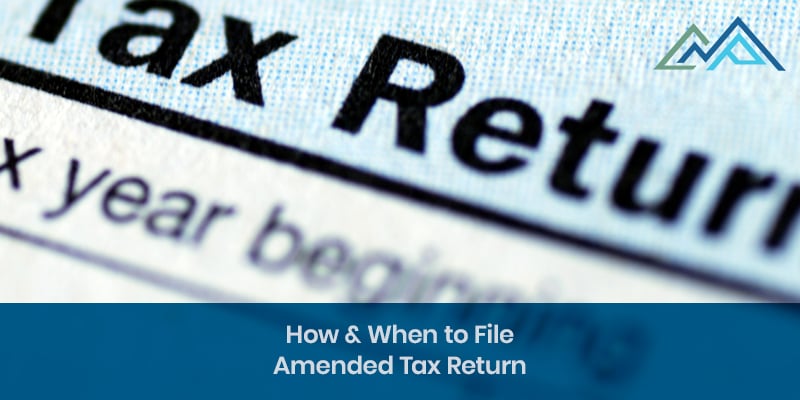Filing your federal income tax return can be stressful even when your taxes are straightforward. But, what happens when you discover that you need to change something on a tax return that's already been filed? The short answer: you need to file an amended tax return with the IRS.

At CMP, we work with our clients to ensure that their taxes are filed accurately and on time. That said, circumstances beyond anyone's control may require an amendment. In this post, we explain how and when to file an amended tax return.
What is an Amended Tax Return?
The possibility of making an error on your federal tax return may be something you haven't considered, but it's important to know what happens if you do. The best remedy is to file an amended tax return with the IRS. An amended return allows you to make one or more changes to your original tax return.
Some of the most common reasons to file an amended return include the following:
- A change in your filing status (married to single, filing separately to filing jointly, etc.)
- A change in your income (you forgot to report income)
- A tax credit taken in error or not taken when it should have been
- A tax deduction taken in error or not taken when it should have been
Of course, you'll need to be careful when filing an amended federal tax return. We'll explain in detail how to file amended returns later in this article, but keep in mind that you will need to use the proper IRS form, attach all required documentation, and adhere to all IRS rules about filing an amended return.
How an Amended Return Works
When you file your individual income tax return, the normal process is that you either enclose payment for the taxes you owe or calculate your refund. You would also enclose or electronically submit any additional tax documents required.
With an amended return, the process is a little different. For example, there are limitations on how and when you may file an amendment electronically. The general rule is that, as of 2021, you may only file an electronic amendment for the 2019 and 2020 tax years. Any previously filed tax return that needs to be amended must be submitted using a paper form.
Another rule that might surprise you is that people who receive tax refunds must wait until after they receive their refund to file an amendment. If this applies to you, you may cash the check for your initial refund if you opted to receive a check, but only if your amended refund is more than your initial refund. If you believe you are entitled to a smaller refund than you received, you should return the uncashed check when you file your amendment. Any additional tax refund will be sent to you separately.
An amended return may take several weeks to process but you can track it online after you submit it electronically or mail it to the IRS.
When to File an Amended Return
When should you file an amended return and when is it not appropriate? Let's start by explaining when an amended return is necessary.
- You used the wrong filing status on your tax return and need to change it.
- You misreported your income in some way, whether you overreported it or forgot to include income from a side gig or investment account.
- You took a credit or deduction in error.
- You missed a credit or deduction.
In other words, anything that involves an informational error on your part should be amended. For example, if you forgot to take the child tax credit or report the profit you earned from your passive income, you will need to file an amended return.
Now, let's talk about when you don't need to file a tax amendment. No amendment is necessary if you:
- Made a math error on your original tax form -- the IRS will correct mathematical errors for you.
- Forgot to include an IRS form or schedule -- the IRS will contact you to request any missing form or documentation.
Another way to look at it is that the IRS will take care of procedural errors, but you will need to report anything that fundamentally changes your taxable income or tax liability.
How to File an Amended Tax Return
Filing an amended tax return isn't difficult, but there are some special rules you should know about. One we already mentioned was that you may only file an electronic amendment for your 2019 and 2020 income taxes. For any previous tax year, you will be required to file a paper form.
Now, let's walk through the steps to file amended returns with the IRS.
- Ensure that the IRS has processed your original return. The reason for this rule is that you want to make sure that your original return doesn't get confused with the amendment.
- Gather all necessary documentation to support your amended tax refund. You will need a copy of your original tax return plus any other documents you might need to support the changes. For example, you might have an amended W-2, the 1099 form you received late, or an IRS form to support a deduction that you forgot to take.
- Get the proper tax forms to file your amendment. For any amendment, you will need Form 1040-X. You may also need one or more of the following forms:
- If you are changing your itemized deductions, you need to file Schedule A.
- For any changes related to your interest or dividend income, you'll need Schedule B.
- For changes related to revenue or expenses from a business or trade, you'll need both Schedule C and Schedule SE.
- For changes to your capital gains and losses, you'll need Form 8949 and Schedule D.
- Complete Form 1040-X. Keep in mind that you'll need to list the income and deductions from your original tax return in Column A, the changes you're making in Column B, and the new, corrected totals in Column C. You can find complete instructions here.
- For tax years 2019 and 2020, you may submit Form 1040-X electronically. For any other tax year, you will need to print 1040-X and all related forms to be filed by mail.
- If you owe taxes, you should include your payment with your filing. Paying immediately helps you to avoid fees and penalties. If you're getting a refund, you can simply wait for the IRS to process your amendment.
Following these steps will ensure that you get all the necessary information to the IRS. Keep in mind that you must file Form 1040-X for each tax year that requires an amendment. You may not amend multiple tax returns on the same form.
Is There a Deadline to File an Amended Tax Return?
The IRS has a tax deadline for most things, so it should come as no surprise that there are deadlines associated with amended tax returns.
If you need to amend your tax return, you will need to file by no later than:
- Three years from the date that you initially filed the return; or
- Two years from the date that you paid the taxes for the tax year in question.
If you miss the deadline, you will also miss your opportunity to receive any additional tax refund you may be due. However, if you owe more than you paid, you should pay the amount you owe as soon as possible even if it's past the deadline. While the IRS rarely goes back more than three years for an audit, they may do so if there are substantial changes or if you have unpaid taxes.
What Happens After You Amend Your Tax Return?
After you file an amendment to your tax return, you should be prepared to wait for the IRS to process the amendment. As a rule, you can expect to wait about 16 weeks to receive any additional refund you are due.
It is reasonable to expect an electronic filing to take less time to process than a filing by mail. The reason is that e-filings are received immediately, while mailed filings take additional time to travel and process.
If the IRS requires any additional documentation for your amendment, they will contact you to request it. That means if you make an error filling out a tax form or schedule, or if you neglect to include a form, they will let you know. Be aware that any mistakes like these will likely add to your waiting time for a refund or resolution.
How to Check an Amended Tax Return Status
Starting three weeks after you file your amended tax return, you can check with the IRS to see if it has been processed.
The easiest way to check the status of your amended return is to visit the IRS website and use the "Where's My Amended Return?" feature. You can find it here.
Let Our Tax Advisors Assist You with Your Tax Returns
Making a mistake on your federal income tax return can be stressful, but it's not difficult to file an amended return and remedy the error. The information we have included here will help you amend your return and get any additional tax refund you may be due.
Do you need help filing your income taxes or amending your federal tax return? Our tax advisors are here to help! Read about our income tax services and book a free consultation today!

















